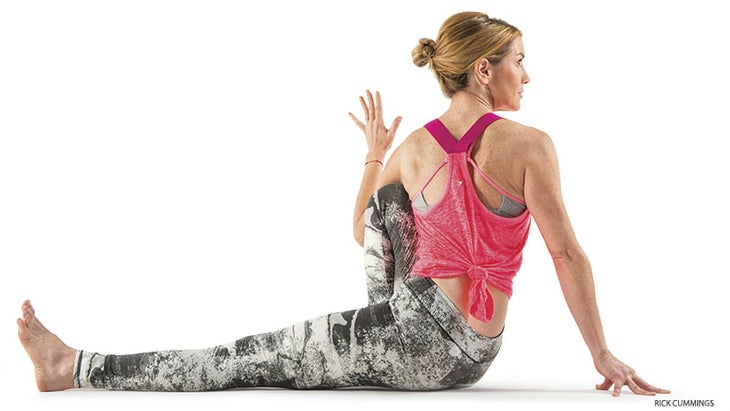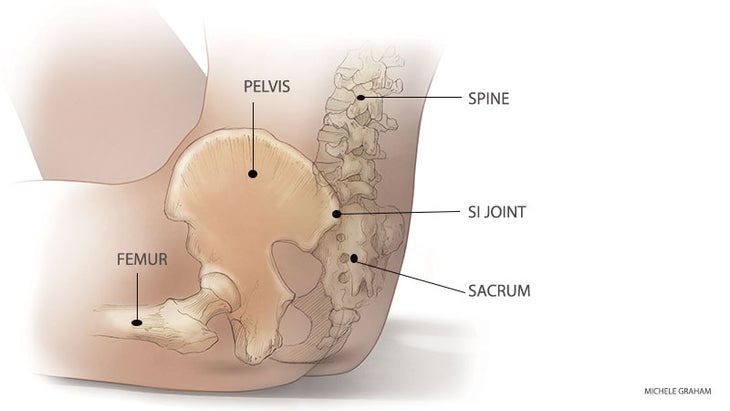Heading out the door? Read this article on the new Outside+ app available now on iOS devices for members! Download the app.

Twisting poses are a top cause of SI joint injury. Learn how to safely anchor yourself before moving into your next twist.
Pain in or near the sacroiliac, or SI, joint—the spot at the base of the spine where the sacrum bone joins the ilium bones of the pelvis—is a growing complaint among yogis. It’s especially common among women, who make up 80 percent of sufferers. That’s in part thanks to hormones related to menstruation, pregnancy, and lactation, which make women’s ligaments more lax and prone to overstretching.
Why Women Are More Prone to SI Injury Than Men
Structural differences play a role, too. Often in women, only two segments of the sacrum articulate (or move) with the pelvis as compared to typically three segments in men, and less surface area touching the joint translates to less stability. The SI joint itself is also shallower in women, further reducing surface contact between bones. Finally, female SI joint surfaces are flatter and not as deeply curved as men’s—they can’t fit together as tightly, like two nesting bowls—and women’s two hip joints tend to be farther apart. Both factors negatively affect the biomechanics of walking, in which the hip joints alternate moving forward one after the other, causing a torqueing force across the pelvis and the SI joint. Though this is a normal action, with an innate slight slippage in the joint, in women the torquing force in the pelvis is greater, potentially stressing the sacral ligaments.
The Key Functions of the SI Joint
Of course, men suffer SI joint pain too, often as a result of inheriting lax ligaments from their parents, or through injury or overstretching in yoga. Regardless of gender, an SI injury can seriously impact your practice and your life. In standing, the weight of the trunk, head, and upper extremities translates laterally out through this joint to the greater pelvis, and then through the pelvis to the legs, and finally to the feet and floor. This makes the SI joint critical to standing, and allows us to bear weight on our bones rather than letting the weight just hang and potentially injure soft tissue like the ligaments. (Ligaments need to have integrity; they’re responsible for holding bone to bone, and if they are overstretched and stressed, the surrounding tissue must work extra hard to help create the needed stability—putting it at risk of injury, too.)
The Sacroilliac Joint in Yoga Poses
On the yoga mat, twisting poses are the top culprit behind SI joint injury. That’s because many students are taught to hold the pelvis still during twists, especially seated ones, and sometimes they’re told to “anchor” the pelvis to the floor during the twist and to keep the sitting bones level. But anchoring the pelvis can lead to overstretching the ligaments holding pelvis to sacrum, and, eventually, chronic achiness and sometimes debilitating pain in the whole SI area.
Consider a seated twist like Marichyasana III. When the pelvis is anchored to the floor at the sitting bones, the twisting must come solely from the spine, which means the sacrum is being dragged into the twist with the rest of the spine, while the pelvis is being held back and thus moves in the opposite direction. Add to this effect the extra torque and force that the arm exerts on the soft tissue around the SI joint when it levers against the outside of the leg to create the twist, and the potential for overstretching the sacral ligaments increases manyfold.
Repeatedly practicing in this way stretches the sacral ligaments that are trying to hold the pelvis and sacrum together, until pain results. In fact, the very definition of SI dysfunction and pain is a condition in which the SI joint is not in its neutral, stable position, with the joint surfaces between pelvis and sacrum aligned.
While I agree that every asana needs an anchor, in twisting poses the anchor is not the pelvis—instead, it’s the thigh, and the foot that is on the floor. The most important thing to remember about the SI joint is that it is a joint of stability, not mobility. If the pelvis is allowed or encouraged to twist first, followed by the spine twisting second, the SI joint will be much happier. The key to protecting the SI joint, be it in standing poses like Trikonasana and Parivrtta Trikonasana, forward bends like Marichyasana I, or seated twists like Marichyasana III, is this: Always move the pelvis and sacrum together.
READ MOREHow to Deal with SI Joint Discomfort

SI Joint Safety In Seated Twists
Marichyasana I
Anchor the “standing” foot and feel the pelvis and spine moving in harmony in this forward-bending posture.
Starting in Dandasana (Staff Pose), bend your right knee, and place the right foot on the floor so that the heel is in line with the sitting bone. This may mean that your heel is not tightly pulled into the buttock, but is a little bit away from it. Wrap your right arm out around the shin of the right leg and catch your left hand behind your back. Exhale and bend forward, letting the right sitting bone come up from the floor to create the forward bend. Anchor the pose from the right foot by pressing it into the floor firmly so it feels as if you are standing on it. This causes the pelvis to tip forward in the pose like it does in all forward bends.
SEE ALSOAsk the Expert: Do Twists Really Wring Out Toxins?
Marichyasana III
Reach the straight leg forward, move the pelvis and sacrum as one, and allow the twist to develop from the base.
Return to Staff Pose. Bend your right leg so the right heel is in line with the right sitting bone, and your shin is exactly vertical. Then move your left (straight) leg forward away from you on the floor so that the pelvis twists. You may find you move your leg four or more inches. You will also notice that your abdomen is already facing the inner thigh of the right, bent leg, and the twist has begun.
Place your left elbow across the right knee; exhale and allow the left sitting bone to come up so only the skin of the left buttock is touching the floor as you shift almost all your weight onto the right foot and sitting bone. Inhale, exhale, and then after the exhalation, introduce the deep-belly organs into the twist. Remember, twists are about the organs and are intended to create a “wringing out” effect, thus contributing to organ health in the kunda, or vessel, of the trunk. With the lungs empty, gradually twist; you will be surprised how far and comfortably you can move into the pose. You’ll also see how easy it is on the SI joint when you allow the pelvis to create the first half of the movement, with the spine and arm creating the second half.
Turn the left thigh inward and stretch out strongly through the ball of the left foot. Imagine you are trying to put the left shoulder blade on the other side of the right knee. Switch legs and repeat both Marichyasana poses on the left.
Above all, never force the body to twist. Twists are gradual and steady poses to be savored in increments of letting go, to allow—not force—the movement. Follow your twisting practice with Uttanasana (Standing Forward Bend) to uncurl the spine in a symmetrical way.
READ MOREPractice Tips for SI Joints
ABOUT OUR EXPERT
Judith Hanson Lasater, PhD, PT, has taught yoga since 1971 on six continents and in most states in America. She is the author of eight books on yoga, including Yogabody: Anatomy, Kinesiology, and Asana. For more information, visit judithhansonlasater.com.